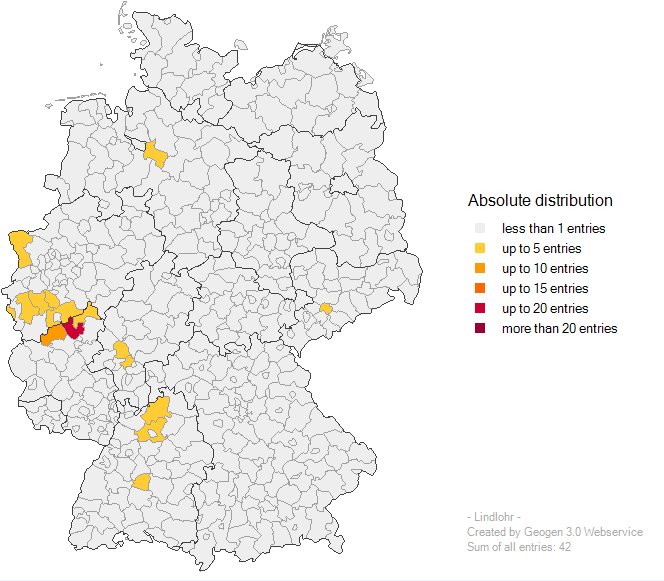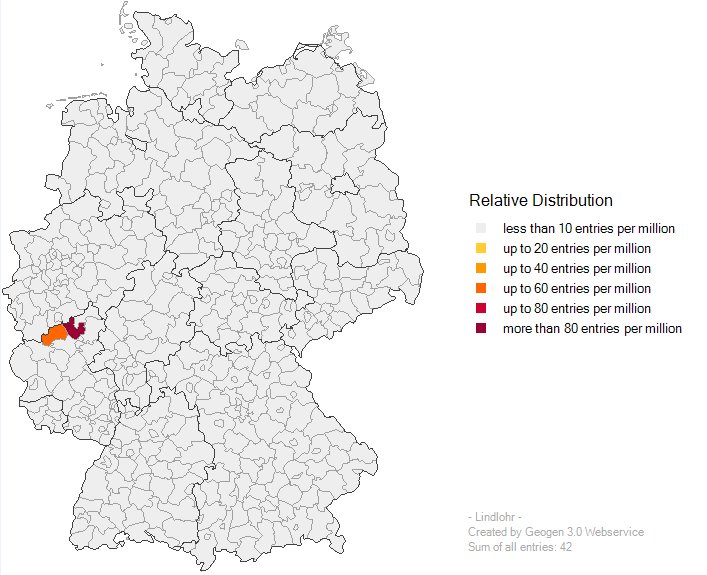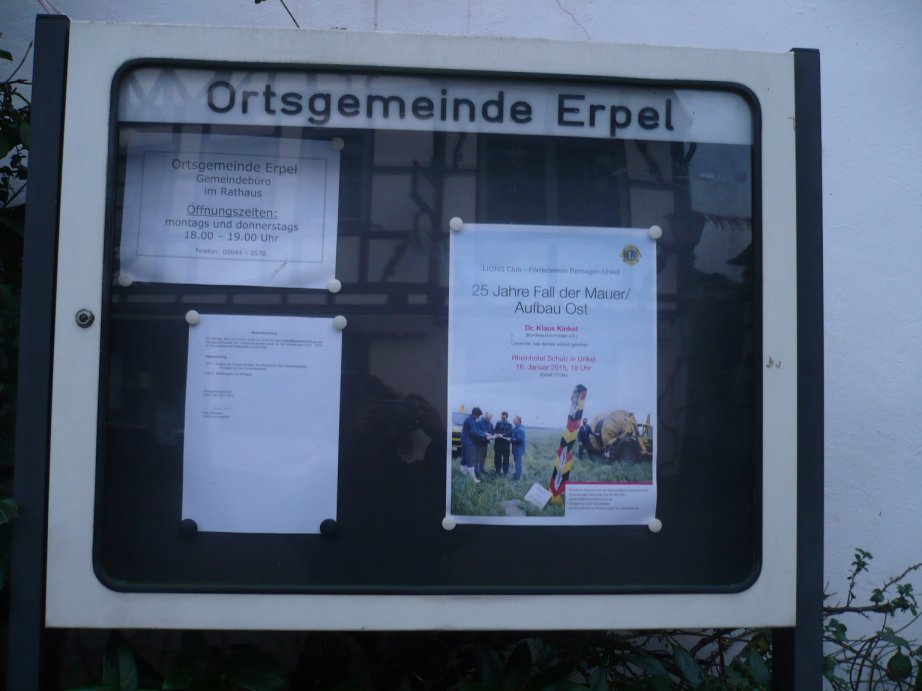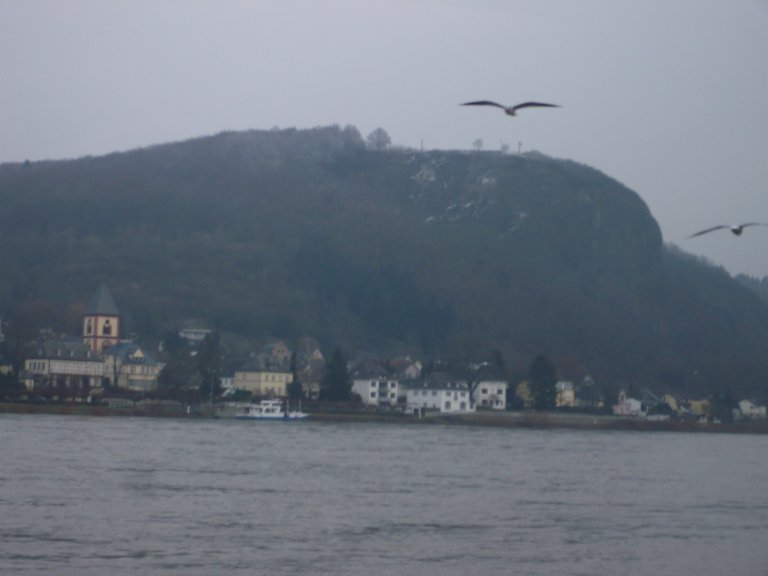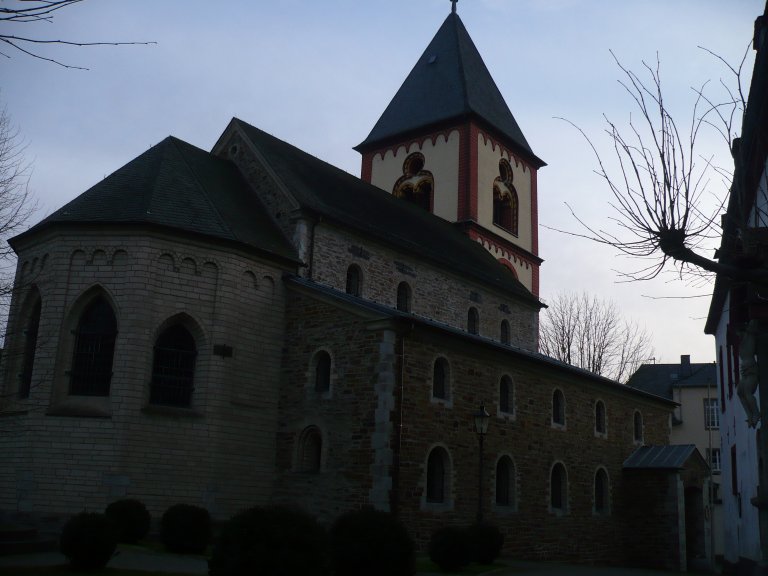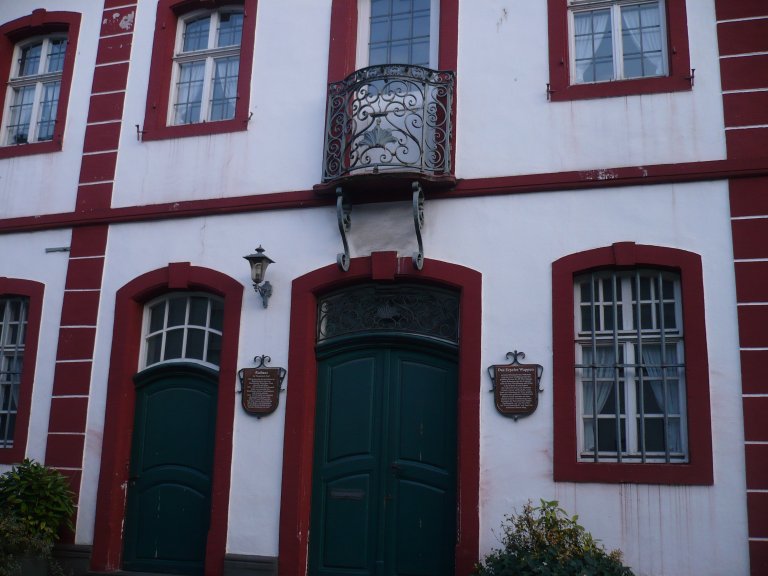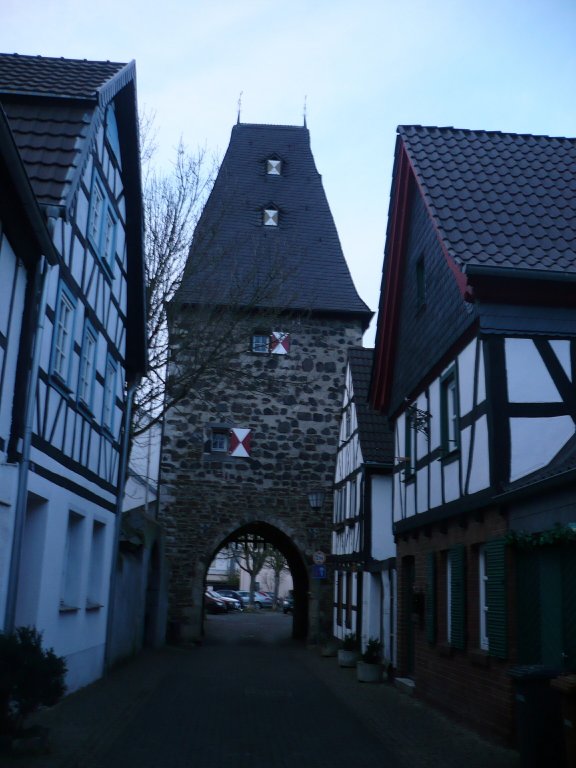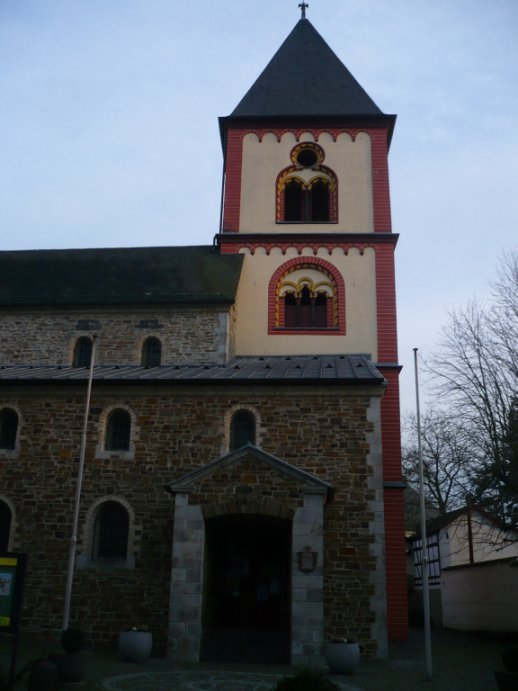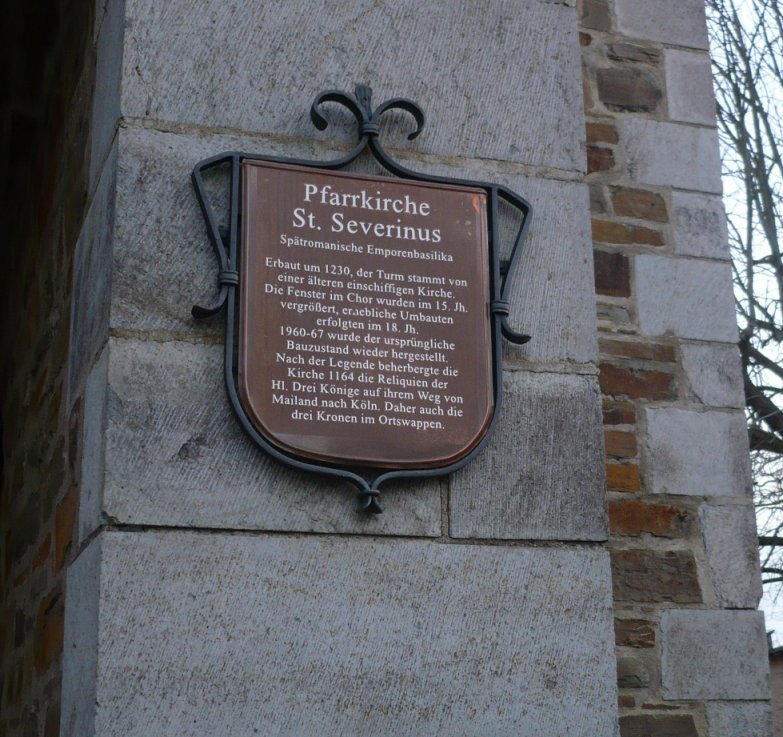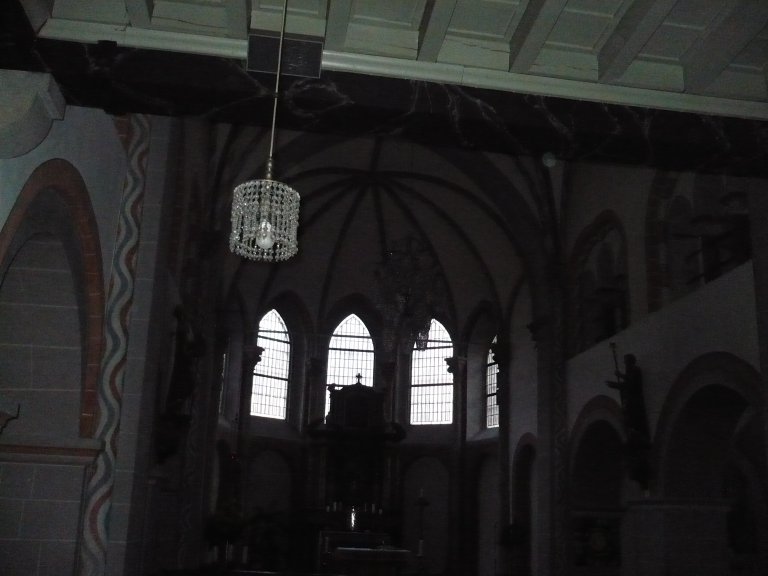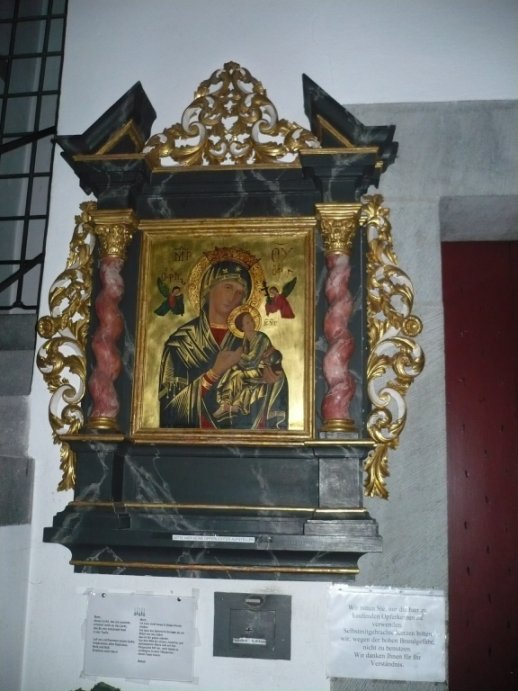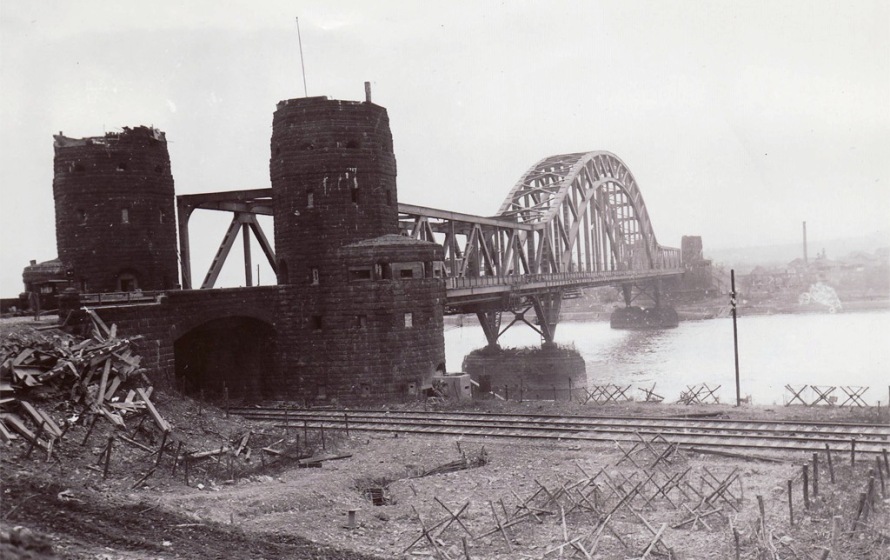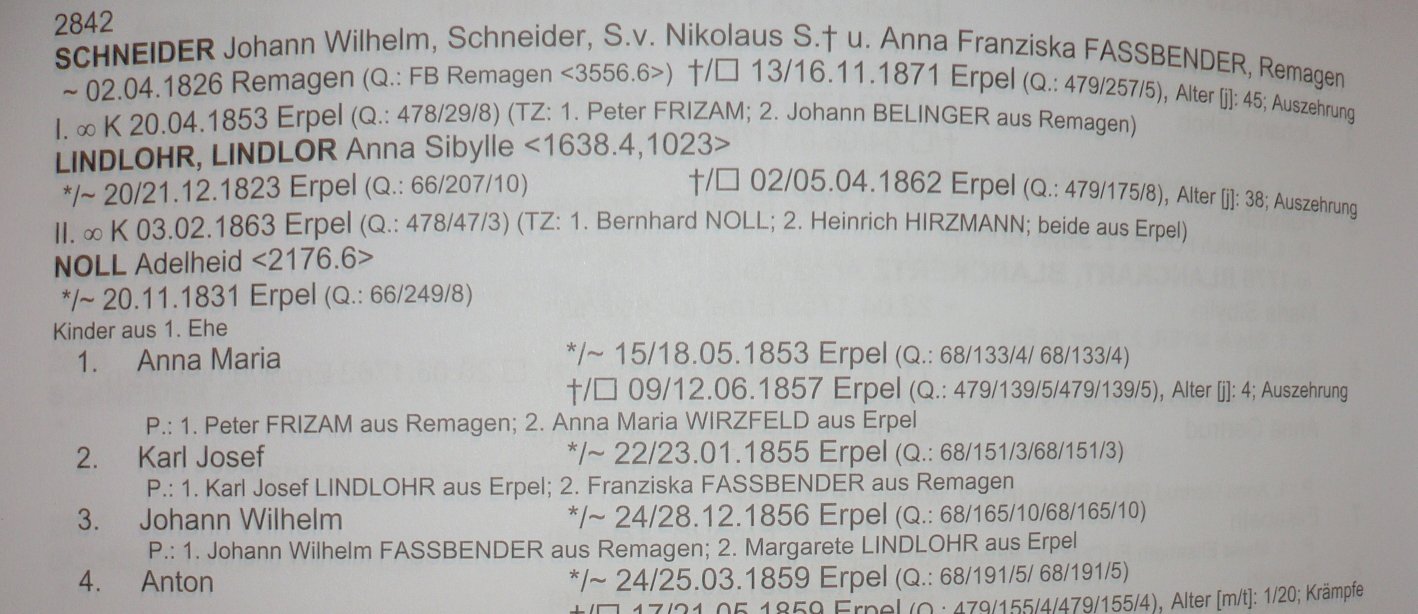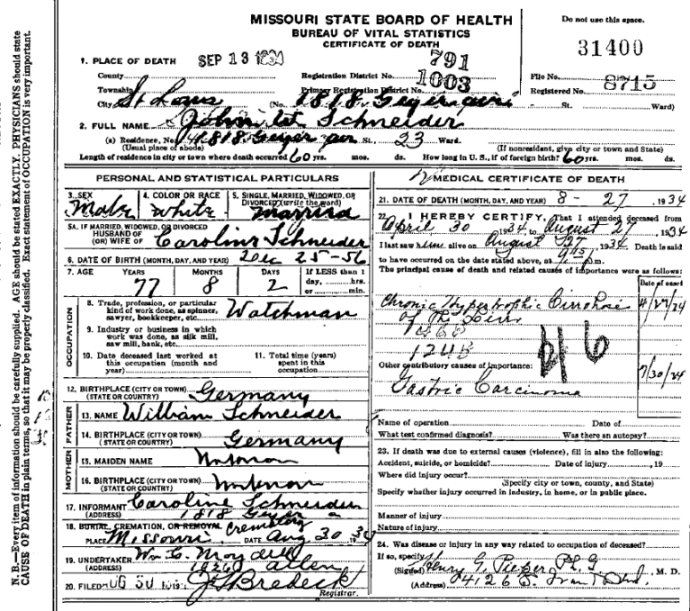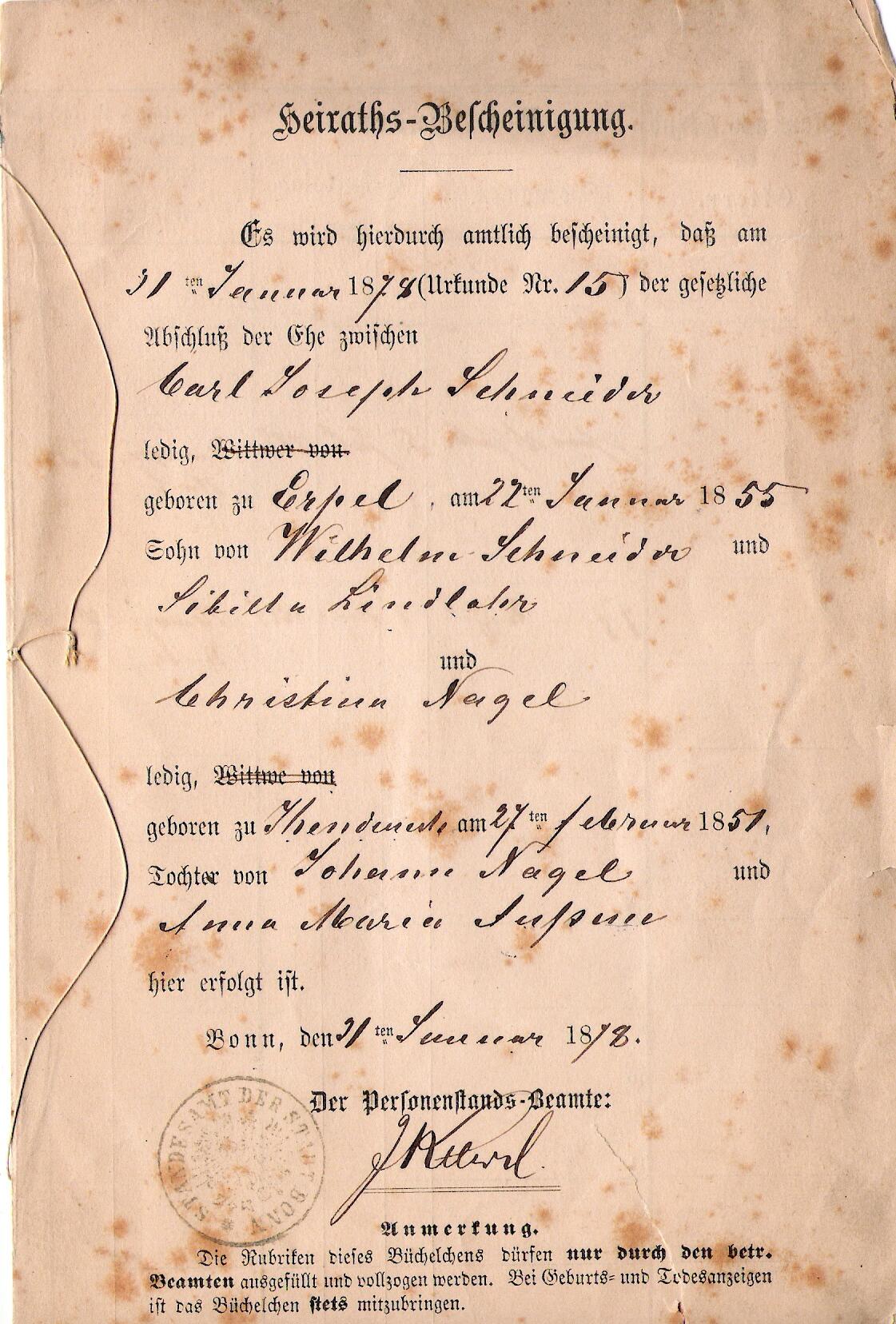My 4th-great-grandmother Agathe Weiler (or Wieler) died 158 years ago today. All that I know about her comes from Familienbuch der katholischen Pfarrei Sankt-Severin, Erpel 1615-1875 by Renate Hentschel (Köln: Westdeutsche Gesellschaft für Familienkunde, 2010.)
I know that Agathe was born about 1789, but I do not know where. I know that she married my 4th-great-grandfather Gottfried Lindlohr before 1817, but I do not know where they married. Gottfried was from Erpel, Neuwied, Rheinland-Pfalz, Germany. Agathe may have been from somewhere else, possibly a nearby town.
Gottfried and Agathe had the following children, all baptized in Erpel:
Karl Josef, born 15 November 1817
Matthias Josef, born 29 February 1820 and died 7 March 1820
Adelheid, born 15 February 1821
Anna Sibylle, born 20 December 1823
Anna Maria, born 22 August 1826
Anna Margarete, born 10 April 1829
Johann Josef, born 23 December 1831
Agathe died on 10 November 1858. The cause of death was Schlagfluß (stroke). She was buried on 13 November 1858 in Erpel.
Covering genealogy, family history, historical events and places, and anything else related!
Showing posts with label Lindlohr. Show all posts
Showing posts with label Lindlohr. Show all posts
Thursday, November 10, 2016
Saturday, October 17, 2015
Surname Saturday: Lindlohr
The maps below show the absolute distribution and relative distribution (considering population density) of the surname Lindlohr in Germany. They were created using Christoph Stöpel's Geogen 3.0 surname mapping site. A newer version, Geogen 4.0, is now available. Both versions use data from German telephone directories.
©Christoph Stöpel. CC BY-NC-SA 2.0 DE (https://creativecommons.org/licenses/by-nc-sa/2.0/de/deed.en). http://legacy.stoepel.net/de/MapGateway.aspx?name=Lindlohr&target=DE&renderer=EN_US&mode=abs
©Christoph Stöpel. CC BY-NC-SA 2.0 DE (https://creativecommons.org/licenses/by-nc-sa/2.0/de/deed.en). http://legacy.stoepel.net/de/MapGateway.aspx?name=Lindlohr&target=DE&renderer=EN_US&mode=rel
The maps show the highest concentration of the surname in Landkreis Neuwied. The next highest concentration is in Landkreis Ahrweiler, which is across the Rhine River.
My known Lindlohr ancestors are:
3rd-great-grandmother: Anna Sibylle Lindlohr
born 20 December 1823, Erpel, Neuwied, Rheinland-Pfalz, Germany
married Heinrich Josef Hellmann 24 June 1845, Erpel, Neuwied, Rheinland-Pfalz, Germany
married Johann Wilhelm Schneider (my 3rd-great-grandfather) 20 April 1853, Erpel, Neuwied, Rheinland-Pfalz, Germany
died 2 April 1862, Erpel, Neuwied, Rheinland-Pfalz, Germany
4th-great-grandfather: Gottfried Lindlohr
born 7 February 1791, Erpel, Neuwied, Rheinland-Pfalz, Germany
married Agathe Weiler
died 13 June 1841, Erpel, Neuwied, Rheinland-Pfalz, Germany
5th-great-grandfather: Johann Lindlohr
baptized 19 January 1760, Erpel, Neuwied, Rheinland-Pfalz, Germany
married Anna Adelheid Wintzen 12 November 1782, Erpel, Neuwied, Rheinland-Pfalz, Germany
died 3 February 1814, Erpel, Neuwied, Rheinland-Pfalz, Germany
6th-great-grandfather: Hermann Lindlohr
married Anna Maria Classen 31 May 1746, Erpel, Neuwied, Rheinland-Pfalz, Germany
married Anna Margarete Brandenburg (my 6th-great-grandmother) 1 May 1758, Erpel, Neuwied, Rheinland-Pfalz, Germany
buried 24 June 1760, Erpel, Neuwied, Rheinland-Pfalz, Germany
Absolute distribution
©Christoph Stöpel. CC BY-NC-SA 2.0 DE (https://creativecommons.org/licenses/by-nc-sa/2.0/de/deed.en). http://legacy.stoepel.net/de/MapGateway.aspx?name=Lindlohr&target=DE&renderer=EN_US&mode=abs
Relative distribution
©Christoph Stöpel. CC BY-NC-SA 2.0 DE (https://creativecommons.org/licenses/by-nc-sa/2.0/de/deed.en). http://legacy.stoepel.net/de/MapGateway.aspx?name=Lindlohr&target=DE&renderer=EN_US&mode=rel
The maps show the highest concentration of the surname in Landkreis Neuwied. The next highest concentration is in Landkreis Ahrweiler, which is across the Rhine River.
My known Lindlohr ancestors are:
3rd-great-grandmother: Anna Sibylle Lindlohr
born 20 December 1823, Erpel, Neuwied, Rheinland-Pfalz, Germany
married Heinrich Josef Hellmann 24 June 1845, Erpel, Neuwied, Rheinland-Pfalz, Germany
married Johann Wilhelm Schneider (my 3rd-great-grandfather) 20 April 1853, Erpel, Neuwied, Rheinland-Pfalz, Germany
died 2 April 1862, Erpel, Neuwied, Rheinland-Pfalz, Germany
4th-great-grandfather: Gottfried Lindlohr
born 7 February 1791, Erpel, Neuwied, Rheinland-Pfalz, Germany
married Agathe Weiler
died 13 June 1841, Erpel, Neuwied, Rheinland-Pfalz, Germany
5th-great-grandfather: Johann Lindlohr
baptized 19 January 1760, Erpel, Neuwied, Rheinland-Pfalz, Germany
married Anna Adelheid Wintzen 12 November 1782, Erpel, Neuwied, Rheinland-Pfalz, Germany
died 3 February 1814, Erpel, Neuwied, Rheinland-Pfalz, Germany
6th-great-grandfather: Hermann Lindlohr
married Anna Maria Classen 31 May 1746, Erpel, Neuwied, Rheinland-Pfalz, Germany
married Anna Margarete Brandenburg (my 6th-great-grandmother) 1 May 1758, Erpel, Neuwied, Rheinland-Pfalz, Germany
buried 24 June 1760, Erpel, Neuwied, Rheinland-Pfalz, Germany
Sunday, September 20, 2015
52 Ancestors: Week 38 "Favorite Place": Anna Sibylle Lindlohr from Erpel, Germany
In January, I traveled to Germany and visited some ancestral places. I loved visiting all of them, but I found Erpel especially beautiful.
Erpel is a local community (Ortsgemeinde) which is part of the collective municipality Unkel, in Kreis (district) Neuwied, in the state of Rhineland-Palatinate (Rheinland-Pfalz). It is located on the eastern bank of the Rhine River, across from Remagen, another ancestral place of mine.
My 2nd-great-grandfather Carl Joseph Schneider was born in Erpel. His father, Johann Wilhelm Schneider, was born in Remagen, and his father's mother's family lived in Remagen for generations. But on his mother Sibylle Lindlohr's side, his roots were in Erpel.
My 3rd-great-grandmother Anna Sibylle Lindlohr was born in Erpel on 20 December 1823. She was the daughter of Gottfried Lindlohr and Agathe Weiler (or Wieler). On 21 December 1823, she was baptized at Pfarrkirche St. Severinus, the Roman Catholic Church in Erpel. Her baptismal sponsors were Peter Wilhelm Stieldorf and Anna Sibylle Lindlohr, represented by Anna Maria Lindlohr.
On 24 June 1845 in Erpel, Sibylle married Heinrich Josef Hellmann from Bad Godesberg. The witnesses to the wedding were Karl Lindlohr and Matthias Jos. Klaeser. Their first child, Maria, was born on 12 March 1846. Another daughter, Adelheid, was born on 23 April 1848, but died a year later, on 26 April 1849. Their son Christian Josef was born on 11 February 1850.
Heinrich Josef Hellman died on 10 October 1850. A little more than a year after losing her husband, Sibylle lost her daughter too; Maria died on 21 February 1852.
Sibylle married my 3rd-great-grandfather Johann Wilhelm Schneider in Erpel on 20 April 1853. The witnesses to the wedding were Peter Frizam and Johann Belinger from Remagen. Less than a month later, on 15 May 1853, their daughter Anna Maria was born. Not long afterward, Sibylle lost another child: her son Christian Josef Hellmann died on 4 July 1853.
Sibylle and Wilhelm's next child, my 2nd-great-grandfather Carl Joseph, was born on 22 January 1855. Their son Johann Wilhelm (later known as John William) was born on 24 December 1856.
Sibylle's first child with Wilhelm, Anna Maria, died on 9 June 1857. Sibylle gave birth to twins, Anton and Maria Josefa, on 24 March 1859. Both children died on 17 May 1859.
Sibylle and Wilhelm had two more children, neither of whom would survive to adulthood: Gottfried, born 25 May 1860 (and died of encephalitis on 24 April 1873) and Maria Anna, born 25 February 1862 (and died 14 January 1863).
Sibylle died in Erpel on 2 April 1862. Her cause of death was listed as Auszehrung (emaciation, consumption, tuberculosis). She was buried on 5 April 1862.
Erpel is a local community (Ortsgemeinde) which is part of the collective municipality Unkel, in Kreis (district) Neuwied, in the state of Rhineland-Palatinate (Rheinland-Pfalz). It is located on the eastern bank of the Rhine River, across from Remagen, another ancestral place of mine.
View of Erpel from Remagen
My 2nd-great-grandfather Carl Joseph Schneider was born in Erpel. His father, Johann Wilhelm Schneider, was born in Remagen, and his father's mother's family lived in Remagen for generations. But on his mother Sibylle Lindlohr's side, his roots were in Erpel.
My 3rd-great-grandmother Anna Sibylle Lindlohr was born in Erpel on 20 December 1823. She was the daughter of Gottfried Lindlohr and Agathe Weiler (or Wieler). On 21 December 1823, she was baptized at Pfarrkirche St. Severinus, the Roman Catholic Church in Erpel. Her baptismal sponsors were Peter Wilhelm Stieldorf and Anna Sibylle Lindlohr, represented by Anna Maria Lindlohr.
Pfarrkirche St. Severinus, the location of many family baptisms, marriages, and funerals
On 24 June 1845 in Erpel, Sibylle married Heinrich Josef Hellmann from Bad Godesberg. The witnesses to the wedding were Karl Lindlohr and Matthias Jos. Klaeser. Their first child, Maria, was born on 12 March 1846. Another daughter, Adelheid, was born on 23 April 1848, but died a year later, on 26 April 1849. Their son Christian Josef was born on 11 February 1850.
Heinrich Josef Hellman died on 10 October 1850. A little more than a year after losing her husband, Sibylle lost her daughter too; Maria died on 21 February 1852.
Sibylle married my 3rd-great-grandfather Johann Wilhelm Schneider in Erpel on 20 April 1853. The witnesses to the wedding were Peter Frizam and Johann Belinger from Remagen. Less than a month later, on 15 May 1853, their daughter Anna Maria was born. Not long afterward, Sibylle lost another child: her son Christian Josef Hellmann died on 4 July 1853.
Sibylle and Wilhelm's next child, my 2nd-great-grandfather Carl Joseph, was born on 22 January 1855. Their son Johann Wilhelm (later known as John William) was born on 24 December 1856.
Sibylle's first child with Wilhelm, Anna Maria, died on 9 June 1857. Sibylle gave birth to twins, Anton and Maria Josefa, on 24 March 1859. Both children died on 17 May 1859.
Sibylle and Wilhelm had two more children, neither of whom would survive to adulthood: Gottfried, born 25 May 1860 (and died of encephalitis on 24 April 1873) and Maria Anna, born 25 February 1862 (and died 14 January 1863).
Sibylle died in Erpel on 2 April 1862. Her cause of death was listed as Auszehrung (emaciation, consumption, tuberculosis). She was buried on 5 April 1862.
Rathaus (town hall), built in 1780
Neutor (New Gate), the only remaining tower of the old city wall
Thursday, March 12, 2015
Those Places Thursday: Pfarrkirche St. Severinus, Erpel, Germany
Pfarrkirche St. Severinus is a Roman Catholic Church in Erpel, Kreis Neuwied, Rheinland-Pfalz (Rhineland-Palatinate), Germany.
The church is a late Gothic column basilica which was built in the mid-13th century. The tower basement is from an earlier nave church which was built in the 11th or early 12th century.
In 1751, the galleries were removed, a new roof was put on the tower, the height was increased on the roofs of the side naves, and the side towers were dismantled.
The church was renovated again in 1960-1967, and the galleries were restored.
According to legend, the original church hosted the remains of the Three Wise Men in 1164, when Rainald von Dassel, Archbishop of Cologne, brought them from Milan, Italy to Cologne.
My great-great-grandfather Carl Joseph Schneider and his siblings were baptized at St. Severinus. His parents Johann Wilhelm Schneider and Anna Sibylle Lindlohr were married there. Many earlier generations of the Lindlohr family attended St. Severinus.
References
A gem of sacral archiecture: Erpel's parish church St. Severinus gets renovated - modifications are part of history
Parish Church St. Severinus
St. Severin (Erpel)
Saturday, March 7, 2015
Capture of the Ludendorff Bridge
The Ludendorff Bridge over the Rhine at Remagen after it was captured by U.S. troops, 7 March 1945. U.S. Signal Corps/ National Archives. Public domain. Available from Wikimedia Commons.
Today is the 70th anniversary of the capture of the Ludendorff Bridge. The bridge connected Remagen and Erpel, two German ancestral towns of mine. It was built in 1918 to carry supplies to the Western Front in World War I, and was named after General Erich Ludendorff. Architect Karl Wiener designed it as a railroad bridge; it had two railroad tracks and a walkway for pedestrians.
On 7 March 1945, the U.S. 9th Armored Division captured the Ludendorff Bridge shortly before 4:00 PM, when they believed the Germans would blow it up. The first American soldier to cross the bridge was Alexander A. Drabik; as the Germans fired at him, he ran across the entire length of the bridge. German-born lieutenant Karl H. Timmermann was the first officer to cross the bridge. More than 8,000 American soldiers crossed over within 24 hours.
14-year-old Heinrich Lindlohr and his family were in the back part of the bridge tunnel at the time of the surrender. About 40 American soldiers were there as well. Heinrich's sister Anni walked toward the soldiers and carried a white flag. Lindlohr is one of my ancestral surnames from Erpel. I could be related to Heinrich and Anni Lindlohr.
On 17 March 1945, the bridge collapsed as a result of the damage it had sustained.
References
Alexander Drabik, 82, First G.I. To Cross Remagen Bridge in 1945
Battle of Remagen
The Bridge of Remagen - Between Truth and Legend: Contemporary witnesses remember March of 1945
Capturing the Bridge at Remagen, 1945
Ludendorff Bridge
The Ludendorff Bridge Erpel - Remagen
Ludendorff-Bridge - "The battle for the bridge is legendary"
Ludendorff-Bridge ... "The Bridge of Remagen"
Remagen
US Troops Capture Ludendorff Railroad Bridge at Remagen
Today is the 70th anniversary of the capture of the Ludendorff Bridge. The bridge connected Remagen and Erpel, two German ancestral towns of mine. It was built in 1918 to carry supplies to the Western Front in World War I, and was named after General Erich Ludendorff. Architect Karl Wiener designed it as a railroad bridge; it had two railroad tracks and a walkway for pedestrians.
On 7 March 1945, the U.S. 9th Armored Division captured the Ludendorff Bridge shortly before 4:00 PM, when they believed the Germans would blow it up. The first American soldier to cross the bridge was Alexander A. Drabik; as the Germans fired at him, he ran across the entire length of the bridge. German-born lieutenant Karl H. Timmermann was the first officer to cross the bridge. More than 8,000 American soldiers crossed over within 24 hours.
14-year-old Heinrich Lindlohr and his family were in the back part of the bridge tunnel at the time of the surrender. About 40 American soldiers were there as well. Heinrich's sister Anni walked toward the soldiers and carried a white flag. Lindlohr is one of my ancestral surnames from Erpel. I could be related to Heinrich and Anni Lindlohr.
On 17 March 1945, the bridge collapsed as a result of the damage it had sustained.
References
Alexander Drabik, 82, First G.I. To Cross Remagen Bridge in 1945
Battle of Remagen
The Bridge of Remagen - Between Truth and Legend: Contemporary witnesses remember March of 1945
Capturing the Bridge at Remagen, 1945
Ludendorff Bridge
The Ludendorff Bridge Erpel - Remagen
Ludendorff-Bridge - "The battle for the bridge is legendary"
Ludendorff-Bridge ... "The Bridge of Remagen"
Remagen
US Troops Capture Ludendorff Railroad Bridge at Remagen
Saturday, October 11, 2014
Sibling Saturday: Carl Joseph and John William Schneider
For a long time, I did not know that my Schneider ancestors had family in St. Louis when they arrived. My great-great-grandparents Carl Joseph and Christina (Nagel) Schneider and their children (including my great-grandfather John Schneider) left Remagen, Ahrweiler, Rheinland-Pfalz, Germany in 1892 and settled in St. Louis. Christina's brother Mathias Nagel had been living in Jefferson City, Missouri, but had moved to Santa Fe, New Mexico in 1891.
While searching the Missouri History Museum's Genealogy and Local History Index, I found an entry for Carl J. Schneider from the weekly periodical Squib. He was mentioned in a biographical sketch. I requested a photocopy from the Missouri History Museum. Although Schneider is a common surname, I thought there was a chance that the entry referred to my great-great grandfather, or to his grandson with the same name (my maternal grandmother's brother). It did not refer to either of them. It was a biographical sketch of a man named John William Schneider. One of his sons was named Carl J. Schneider. The Missouri History Museum thoughtfully included extra information about John William Schneider; they also sent his death certificate and a copy of his death notice.
I looked over the information, and a theory began to form. The biographical sketch said that John William Schneider was born in Erpil, Germany on 25 December 1856. My great-great-grandfather Carl Joseph Schneider was born in Erpel, Neuwied, Rheinland-Pfalz, Germany on 22 January 1855. "Erpil" looked like a misspelling of "Erpel." The two men were close in age. John William Schneider's death notice mentioned that he was an uncle, and his oldest son shared a first name and middle initial with my great-great-grandfather. His death certificate stated that his father was William Schneider, born in Germany (likely Wilhelm), and his mother was unknown. Carl Joseph Schneider's father was Johann Wilhelm Schneider, and he was called Wilhelm. His mother was Sibylle Lindlohr, who had died in Erpel on 2 April 1862, when she was only 38 years old. John William Schneider had died of chronic hypertrophic cirrhosis of the liver, but gastric carcinoma was listed as a contributory cause of death. Carl Joseph Schneider had died of stomach cancer. When Carl Joseph Schneider wrote a letter to his wife and children while visiting Germany in 1900, he mentioned receiving "brother's letter." This statement implied that his brother was not living in Germany. I suspected that his brother was John William Schneider. However, I could not prove it right away. Catholic church records from Erpel are not available through the Family History Library. I had information about Carl Joseph Schneider's parents and maternal grandparents from the book Familienbuch der katholischen Pfarrei Sankt Peter und Paul Remagen, 1649 bis 1899, by Gerhard Hentschel (Köln: Westdeutsche Gesellschaft für Familienkunde, 2007). However, the book only listed one child for them: a daughter, Maria Anna, who died in 1863 when she was not quite a year old and was buried in Remagen. Carl Joseph Schneider was not even listed as their son, but I knew that he was their son; his marriage certificate names his parents. He was born in Erpel (just across the Rhine River), so he was not recorded in the Remagen book.
In 2010, the book Familienbuch der katholischen Pfarrei Sankt Severin Erpel 1615-1875 (Köln: Westdeutsche Gesellschaft für Familienkunde), by Gerhard Hentschel's wife Renate, was published. I obtained a copy, and finally found the proof that I had been searching for. In the list of children of my my 3rd-great-grandparents Johann Wilhelm Schneider and Anna Sibylle Lindlohr, underneath the entry for my great-great-grandfather, was one for Johann Wilhelm Schneider, born 24 December 1856 in Erpel. The two men were brothers.
Carl Joseph Schneider's father-in-law Johann Nagel, his children's only living grandparent, died in Remagen on 15 February 1891. The following year, Carl and his wife and children moved to St. Louis, Missouri to join his brother, his only living full sibling.
I believe that John William Schneider wanted to be found. If I had not received the information from the Missouri History Library, I probably would not have found him. Even though I still would have learned about him from the Erpel Familienbuch, I would not have known that he went to St. Louis. Although researching others with the same surname can lead to finding relatives, this approach does not work so well with common surnames like Schneider, especially in an area like St. Louis, with a large German population. And after learning that his son Ferdinand had died in World War I, I believe that John wanted me to find him too.
Biographical sketch of John William Schneider. Squib, circa 1911. From the collection of the Missouri Historical Society.
Family of Johann Wilhelm Schneider and Anna Sibylle Lindlohr. Hentschel, Renate. Familienbuch der katholischen Pfarrei Sankt Severin Erpel 1615-1875. Köln: Westdeutsche Gesellschaft für Familienkunde, 2010.
John W. Schneider death certificate, 27 August 1934. Missouri State Board of Health. Bureau of Vital Statistics.
While searching the Missouri History Museum's Genealogy and Local History Index, I found an entry for Carl J. Schneider from the weekly periodical Squib. He was mentioned in a biographical sketch. I requested a photocopy from the Missouri History Museum. Although Schneider is a common surname, I thought there was a chance that the entry referred to my great-great grandfather, or to his grandson with the same name (my maternal grandmother's brother). It did not refer to either of them. It was a biographical sketch of a man named John William Schneider. One of his sons was named Carl J. Schneider. The Missouri History Museum thoughtfully included extra information about John William Schneider; they also sent his death certificate and a copy of his death notice.
I looked over the information, and a theory began to form. The biographical sketch said that John William Schneider was born in Erpil, Germany on 25 December 1856. My great-great-grandfather Carl Joseph Schneider was born in Erpel, Neuwied, Rheinland-Pfalz, Germany on 22 January 1855. "Erpil" looked like a misspelling of "Erpel." The two men were close in age. John William Schneider's death notice mentioned that he was an uncle, and his oldest son shared a first name and middle initial with my great-great-grandfather. His death certificate stated that his father was William Schneider, born in Germany (likely Wilhelm), and his mother was unknown. Carl Joseph Schneider's father was Johann Wilhelm Schneider, and he was called Wilhelm. His mother was Sibylle Lindlohr, who had died in Erpel on 2 April 1862, when she was only 38 years old. John William Schneider had died of chronic hypertrophic cirrhosis of the liver, but gastric carcinoma was listed as a contributory cause of death. Carl Joseph Schneider had died of stomach cancer. When Carl Joseph Schneider wrote a letter to his wife and children while visiting Germany in 1900, he mentioned receiving "brother's letter." This statement implied that his brother was not living in Germany. I suspected that his brother was John William Schneider. However, I could not prove it right away. Catholic church records from Erpel are not available through the Family History Library. I had information about Carl Joseph Schneider's parents and maternal grandparents from the book Familienbuch der katholischen Pfarrei Sankt Peter und Paul Remagen, 1649 bis 1899, by Gerhard Hentschel (Köln: Westdeutsche Gesellschaft für Familienkunde, 2007). However, the book only listed one child for them: a daughter, Maria Anna, who died in 1863 when she was not quite a year old and was buried in Remagen. Carl Joseph Schneider was not even listed as their son, but I knew that he was their son; his marriage certificate names his parents. He was born in Erpel (just across the Rhine River), so he was not recorded in the Remagen book.
In 2010, the book Familienbuch der katholischen Pfarrei Sankt Severin Erpel 1615-1875 (Köln: Westdeutsche Gesellschaft für Familienkunde), by Gerhard Hentschel's wife Renate, was published. I obtained a copy, and finally found the proof that I had been searching for. In the list of children of my my 3rd-great-grandparents Johann Wilhelm Schneider and Anna Sibylle Lindlohr, underneath the entry for my great-great-grandfather, was one for Johann Wilhelm Schneider, born 24 December 1856 in Erpel. The two men were brothers.
Carl Joseph Schneider's father-in-law Johann Nagel, his children's only living grandparent, died in Remagen on 15 February 1891. The following year, Carl and his wife and children moved to St. Louis, Missouri to join his brother, his only living full sibling.
I believe that John William Schneider wanted to be found. If I had not received the information from the Missouri History Library, I probably would not have found him. Even though I still would have learned about him from the Erpel Familienbuch, I would not have known that he went to St. Louis. Although researching others with the same surname can lead to finding relatives, this approach does not work so well with common surnames like Schneider, especially in an area like St. Louis, with a large German population. And after learning that his son Ferdinand had died in World War I, I believe that John wanted me to find him too.
Biographical sketch of John William Schneider. Squib, circa 1911. From the collection of the Missouri Historical Society.
John William Schneider. Squib, circa 1911. From the collection of the Missouri Historical Society.
Carl Joseph Schneider. Photo taken at Pietz, 1630 Franklin Ave., St. Louis, Missouri.
Family of Johann Wilhelm Schneider and Anna Sibylle Lindlohr. Hentschel, Renate. Familienbuch der katholischen Pfarrei Sankt Severin Erpel 1615-1875. Köln: Westdeutsche Gesellschaft für Familienkunde, 2010.
Certificate of death, Carl Joseph Schneider, 5 November 1901. Ancestry.com. Missouri, Death Records, 1834-1910 [database on-line]. Provo, UT, USA: Ancestry.com Operations, Inc., 2008. Original data: Missouri Death Records. Jefferson City, MO, USA: Missouri State Archives. Microfilm.
John W. Schneider death certificate, 27 August 1934. Missouri State Board of Health. Bureau of Vital Statistics.
Wednesday, April 2, 2014
Wedding Wednesday: Carl Joseph Schneider and Christina Nagel
My great-great-grandparents Carl Joseph Schneider and Christina Nagel were married in Bonn, Germany on 31 January 1878. Carl Joseph Schneider was born in Erpel, Neuwied, Rheinland on 22 January 1855. He was the son of Wilhelm Schneider and Sibilla Lindlohr. Christina Nagel was born on 27 February 1851 in Kendenich, Rhein-Erft, Rheinland. She was the daughter of Johann Nagel and Anna Maria Aussem.
Subscribe to:
Posts (Atom)

